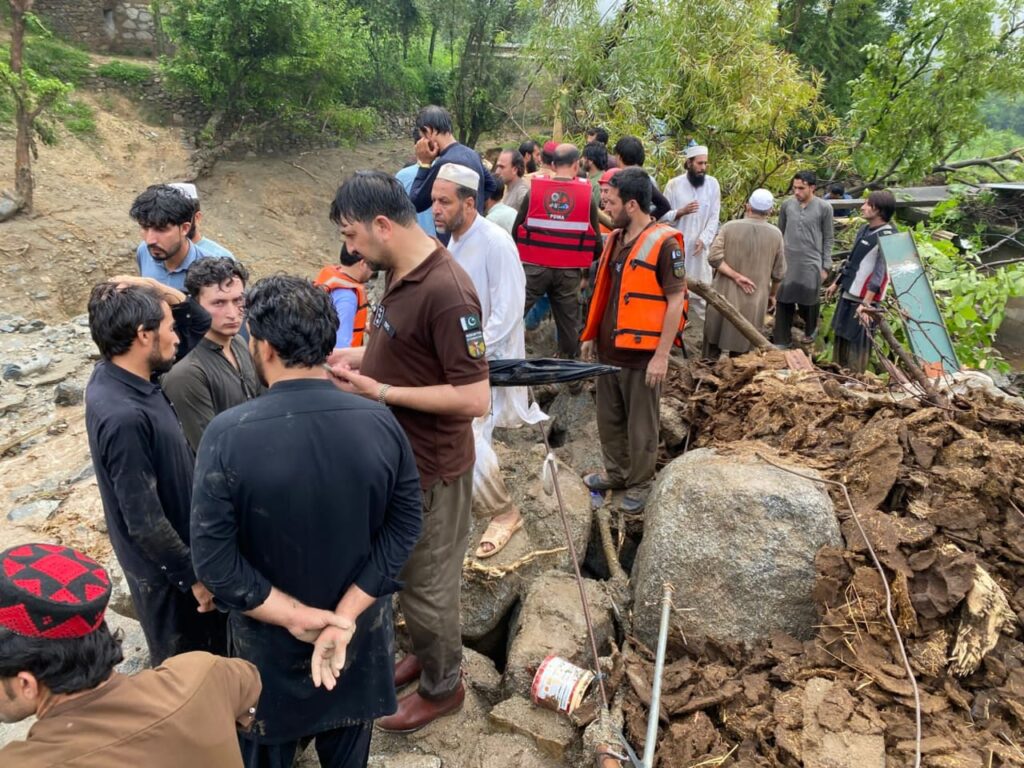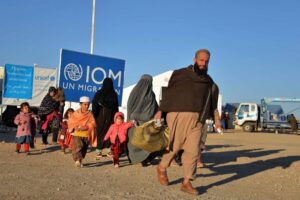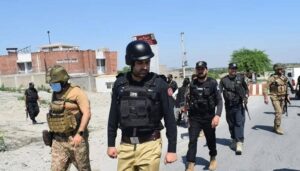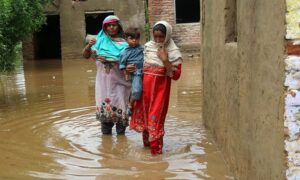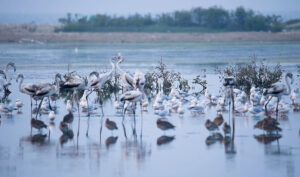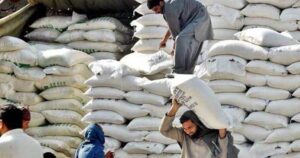PIR BABA — The last time Zahid Buneri saw his children, they were asleep on thin mattresses, huddled together against the chill of a mountain night. Hours later, the roof gave way under a sudden roar of water and rock, and the small house was gone.
“They didn’t even have time to wake up,” he whispered, standing barefoot in the mud where her home once stood. “The mountain just swallowed them.” In Buner district, where the slopes are steep and the valleys narrow, the toll has been devastating. At least 91 people have died here, many in the tehsil of Chagharzai, where five members of a single family were buried when their home collapsed under debris.
Situation in Buner. pic.twitter.com/9LAArpuoq0
— Ihtisham Ul Haq (@iihtishamm) August 15, 2025
Deputy Commissioner Kashif Qayyum confirmed the district’s grim tally: 72 bodies to Tehsil Hospital Gadizai, 12 to the District Headquarters Hospital in Dagar, five to Chagharzai, and two to Gagra. Water levels are now receding, but Qayyum warned the death toll could still rise. A state of emergency has been declared.
In Pir Baba, local sources say floodwaters swept away half the settlement’s population. Seventy-two bodies have been recovered, with more residents still missing. Many survivors were injured and taken to local hospitals, while rescue teams worked around the clock in submerged and destroyed neighborhoods.
Buner (Pir Baba) is drowning. Floods have already taken 20 precious lives. Families are stranded, children are crying for help, homes are gone.
— SHAKIR BUNERI (@SHAKIRU25961231) August 15, 2025
We beg the Government & NDMA send rescue teams, pic.twitter.com/xniOWwoal1
A province under siege
The Provincial Disaster Management Authority (PDMA) has reported incidents across Bajaur, Battagram, Torghar, Mansehra, Swat, Buner, and Shangla. At least 35 houses have been damaged — seven completely destroyed, 28 partially — with the worst destruction in Buner, Bajaur, and Battagram.
In Bajaur’s Salarzai tehsil, a combination of lightning strikes and flash floods killed 21 people. Eighteen bodies have been recovered; three remain missing. Among the dead are women and children. Four houses were destroyed, and three people were injured, one critically, and transferred to Peshawar. Deputy Commissioner Shahid Ali said landslides have blocked roads, forcing rescue teams to walk for hours to reach affected areas. Frontier Corps North deployed helicopters to deliver tents and essential supplies to stranded residents.
In Hazara division, a cloudburst struck the border village of Nailband between Battagram and Mansehra at about 3 a.m. Thursday night, sweeping away three to four houses. Deputy Commissioner Ishtiaq Ahmed confirmed 21 deaths in Dheri Haleem — 11 bodies recovered in Shamlai, Battagram, and 10 people still missing.
That’s a #ClimateCatastrophe unfolding in Khyber Pakhtunkhwa. Over 150 lives reportedly lost so far, many missing. Houses, shops and many villages swept away, especially in Buner. Heartfelt prayers for the fellow citizens devastated by the tragedy. 🙏🏻 pic.twitter.com/UftesFwKVd
— Maleeha Manzoor (@MaleehaManzoor) August 15, 2025
Floodwaters also engulfed Nailband, Saram, and Malakal Gali. Rescue 1122 teams are still searching, but intermittent rain and a near-total collapse of mobile networks have made communication and coordination difficult.
In Mansehra’s Bassiain area, floodwaters swept away a vehicle carrying six passengers. Three survived, two drowned — Mir, 30, and Asad, 25 — and one was injured. In Dheri Haleem, a landslide destroyed 15 houses, trapping 35 people. In Lower Dir’s Maidan Suri Pa, the roof of a home collapsed, killing five and injuring two. Rescue 1122 teams trekked three hours on foot through floodwaters and hazardous terrain to retrieve them.
Chief Minister Ali Amin Gandapur has ordered all available resources for rescue and relief. He has instructed the Malakand commissioner and Bajaur deputy commissioner to personally oversee operations, and directed district administrations in Dir and Swat to remain on high alert.
Tragic: At least 198 people have died and several remain missing after flash #floods devastated the Khyber Pakhtunkhwa province of #Pakistan (as per the Provincial Disaster Management Authority). Buner was the worst-hit district, recording 91 fatalities.
— Raza Ahmad Rumi (@Razarumi) August 15, 2025
(Images v @SkyNews) pic.twitter.com/3w1FT86pNE
As rescue teams battled the flooding on the ground, disaster struck from the air. On Friday, a government MI-17 helicopter delivering relief supplies to flood-hit Bajaur crashed in the Pandiyali area of Mohmand district, killing all five crew members, including two pilots.
Officials said the crash was caused by adverse weather conditions during the ongoing monsoon relief effort. The helicopter had been carrying tents, food, and emergency equipment to isolated valleys cut off by flood damage.
Chief Minister Gandapur declared a day of mourning in Khyber Pakhtunkhwa. The national flag will fly at half-mast, and the crew members will receive full state honors. Gandapur called them “heroes who sacrificed their lives to save others.”
The crash underscores the risks faced by those trying to reach communities marooned by washed-out roads, collapsed bridges, and unstable slopes that could give way at any moment.
The fingerprints of climate change
Pakistan’s summer monsoon has always been fierce, but scientists say a warming climate is loading the dice toward more extreme rainfall. Warmer air holds more moisture, turning seasonal rains into sudden, overwhelming torrents. The steep, deforested slopes of northern Pakistan provide little buffer when the skies open.
Gadezi Oirbaba is submerged under floodwaters, and half of Beshonai village has been wiped away. So far, 80 bodies have been recovered, and locals are tirelessly carrying out rescue operations. A truly tragic and devastating day for Buner. #Bunderflood! pic.twitter.com/DQ4cL5zBMY
— 𝐖ᴀʜᴀʙ 𝐙𝐱 ツ (@wahab_zx) August 15, 2025
Just two years after record-breaking floods submerged a third of the country, rainfall patterns have shifted again: storms arrive in shorter, sharper bursts; lightning strikes are more frequent; and cloudbursts — once rare — are striking with disturbing regularity.
For mountain communities, the danger is compounded by poor infrastructure, limited early-warning systems, and few safe evacuation routes. The PDMA continues to warn of further rain, flash floods, and landslides in the days ahead.
For survivors like Zahid Buneri, the science is distant — but the reality is immediate. He has buried his children and now stands in the ruins of his home, watching the clouds gather again over the dark green slopes. “We know this will happen again,” she said softly. “We just don’t know when — or if we’ll survive the next time.”

